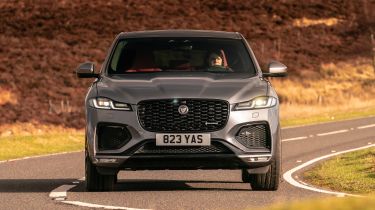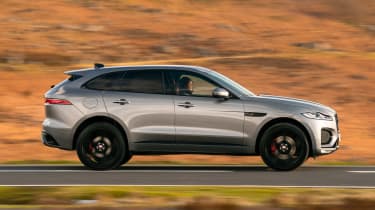Jaguar F-Pace SUV - Engines, drive & performance
The Jaguar F-Pace is a great car to drive and with strong, powerful engines, there should be something for most tastes
While you may not expect it from an SUV, the Jaguar F-Pace is a thoroughly involving and rewarding car to drive. Its steering is accurate and inspires confidence, responding intuitively to your inputs. The development work Jaguar has performed on the F-Pace’s suspension has clearly paid off, as potholes and poor road surfaces are nicely smoothed out. It’s worth noting that the optional 22-inch alloy wheels can cause the worst road surfaces to send shudders through the car. Road noise is still minimal, though – aided by a clever noise cancelling system.
All F-Pace models get four-wheel-drive, although this only comes into play if it senses a loss of traction; the F-Pace behaves like a rear-wheel-drive car by default, although 100% of the engine’s power can be sent to the front wheels if needed. In corners, the F-Pace displays relatively little body lean, and it’s easy to forget you’re driving a big SUV when you find yourself on a twisty back road.
A manual gearbox was available on entry-level cars when the F-Pace first launched, but we’d definitely opt for the now-standard automatic. It suits the F-Pace perfectly, switching seamlessly between its eight gears, so you're unlikely to miss changing gears yourself.
More reviews
In-depth reviews
Road tests
Used car reviews
With a massive 5.0-litre V8 engine in SVR guise, the F-Pace remains taught and nimble on a twisty road. Upgraded suspension, huge brakes, a burbling exhaust sound and revisions to the accelerator and gearbox all make the fastest F-Pace feel even more responsive to the driver's inputs, without completely ruining its laid-back SUV character. Overall, the F-Pace SVR feels less highly strung than the Alfa Romeo Stelvio Quadrifoglio, but it still has the best-sounding engine, which arguably makes it more exciting.
While a Range Rover Evoque or Land Rover Discovery Sport will ultimately be able to tackle rougher terrain, the F-Pace is more capable off-road than you might expect. There are a variety of electronic gadgets to help you keep control, beginning with the standard Drive Control system that allows you to choose between Rain, Ice and Snow settings. There’s also the optional (and more complex) Adaptive Surface Response system, which detects surface conditions automatically and adjusts the car's settings accordingly.
Jaguar F-Pace diesel engines
Jaguar has streamlined the F-Pace’s diesel engine range for 2023, cutting out the entry-level 163bhp D165 engine – something that perhaps felt a tad underpowered for such a large and sporty SUV. The 2.0-litre four-cylinder D200 now kicks off the range, producing 201bhp and getting from 0-62mph in 8.2 seconds. Selecting S mode on the automatic gearbox makes the driving experience a bit more involving – even if the engine becomes a little noisy when you’re accelerating hard.
Costing around £6,700 more than a like-for-like 2.0-litre diesel F-Pace, the 3.0-litre six-cylinder D300 is a significant step up in terms of performance. With 296bhp at its disposal, the F-Pace D300 will get from 0-62mph in just 6.4 seconds, while overall feeling much more substantial and responsive than the smaller 2.0-litre. However, with such a huge price gap – note the V6 isn’t available in entry R-Dynamic S trim – we’re not sure if it’s really worth the extra cash unless you’re an especially keen driver.
Petrol engines
The 247bhp P250 model really only makes sense for lower-mileage drivers as the D200 is slightly cheaper and more economical, if marginally less powerful. With a turbocharged 2.0-litre four-cylinder petrol engine at its disposal, the P250 will get from 0-62mph in 7.3 seconds and suits the F-Pace’s sporty character better than the slightly gruff diesels – although it is still rather noisy when revved hard.
New for the facelifted F-Pace, there's also a 3.0-litre six-cylinder P400 with mild-hybrid assistance. The hybrid badge is best taken with a pinch of salt – this is hardly the best choice for company car drivers – but there's no denying the P400 is fun. With 395bhp and a cultured growl under acceleration, the P400 gives the F-Pace a sporting edge that could tempt some drivers away from the hardcore and much more expensive SVR.
However, if you're looking for absolute performance, the F-Pace SVR is your top choice. A facelift in early 2021 saw the introduction of several minor chassis and drivetrain tweaks. Alongside an evocative exhaust note, the 5.0-litre supercharged V8 petrol engine produces 542bhp, making it capable of 0-62mph in four seconds and a top speed of 178mph.
Hybrid engine
Headlining the update for 2023 was a revised F-Pace P400e plug-in hybrid model with a larger battery and greater electric range. Like before, this produces 399bhp – making it the most powerful F-Pace, bar the SVR – and gets from 0-62mph in five seconds.
In EV mode, the electric motor is just powerful enough to get the two-tonne SUV up to speed in town but on faster roads it's best to leave it in hybrid mode. Do so, and the combined pulling power of the petrol engine and electric motor gives the F-Pace a more impressive turn of speed. We remain unconvinced by the artificial V8 soundtrack pumped through the speakers in Dynamic mode, while the added weight of the batteries does make the F-Pace marginally less sharp on a twisty road.










